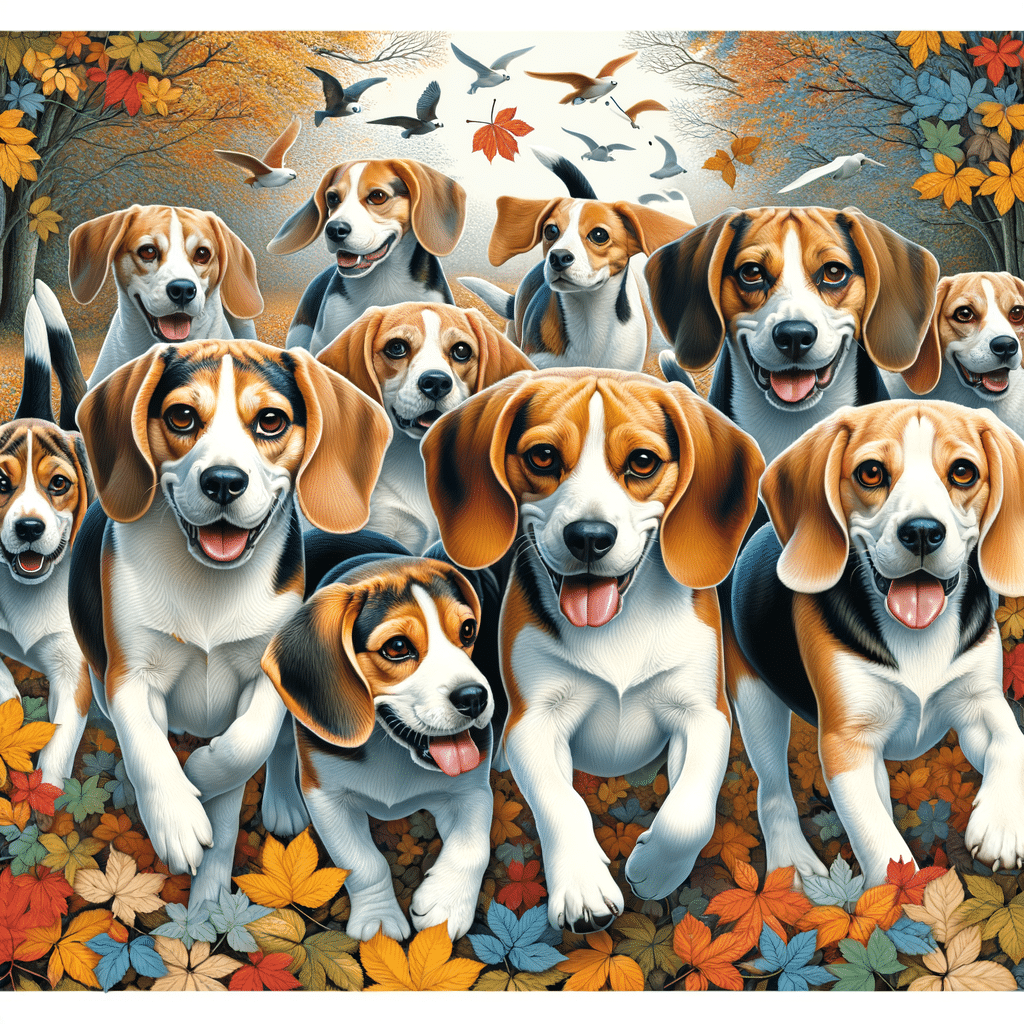Among dog breeds, the beagle and the foxhound hold respected places for their keen sense of smell and hunting skills. While they share common ancestors and have similarities in appearance and purpose, they have distinct differences that make each breed suitable for different environments and you as an owner.
In This Article
Understanding the differences and similarities is key when selecting one of these popular dog breeds, beagle vs. foxhound. Beagles are smaller and have a friendlier temperament, making them a common choice for family pets. Foxhounds are larger and showcase more independence, ideal for those seeking a dog with stamina and a strong work ethic.
Choosing between a beagle and a foxhound involves lifestyle, compatibility, and personal preference. Beagles adapt better to indoor living. They are less demanding regarding exercise, while foxhounds require ample space to roam for physical activity.
Health concerns also vary between the two breeds. Each has specific genetic issues. Understanding these key characteristics is essential for making an informed decision to fit your living arrangements, activity levels, and expectations for your new dog.
Highlights
- Beagles and foxhounds differ in size, energy levels, and temperament.
- The choice of breed should consider the owner’s lifestyle and the dog’s exercise needs.
- Health and care requirements are specific to each breed and important for ownership decisions.
Breed Origins and History
The beagle and foxhound breeds both stem from a rich history in England. They share ancestral roots yet have evolved distinctly to suit different hunting purposes throughout time through the work of dog breeders.
Beagle Origins and Evolution
The beagle’s history can be traced back to England before Roman times. They are possibly descended from hounds of ancient Greece, later brought to England by the Romans. The Spanish pointer and existing English hounds influenced further breed development.
The modern beagle focused on rabbit hunting to suit the needs of hunters on foot, a practice that earned them recognition during the era of Queen Elizabeth I. Small beagle-like dogs called “glove beagles” used their scent-tracking abilities for this purpose
Endearing traits of beagles include:
- Excellent sniffers
- Compact size
- Affable nature
Foxhound Historical Development
The foxhound’s development is similar to that of the beagle. However, its primary purpose was hunting larger game, such as foxes, which required a larger dog. The English foxhound is the direct ancestor of the American foxhound.
The breed’s establishment in the United States dates back to 1650 when Robert Brooke brought hunting dogs to the colonies in Virginia. These dogs laid the foundation for various hound breeds. Notable figures such as George Washington considerably influenced the American foxhound’s history, interbreeding the English foxhound with French hounds to refine the breed’s attributes.
Significant milestones include:
- George Washington‘s role in breeding
- Adaptation to the American terrain
- Distinguished lineage from Virginia estates
Physical Characteristics and Health
When comparing beagles to foxhounds, distinctions in size and health are significant. The physical attributes factor heavily into care requirements, while health considerations inform potential medical needs throughout their lifespan.
Size and Appearance Differences
Foxhounds are considerably larger than beagles. They typically stand 21-25 inches tall and weigh between 60-70 pounds. Their narrow chest is part of their breed’s physical build. On the other hand, beagles are smaller, usually 13-15 inches tall, and weigh 20-30 pounds.
In terms of coat and fur, both breeds possess a short, dense coat known for shedding moderately. Regular grooming can manage the shedding; foxhounds and beagles have moderate grooming needs. Both breeds will leave some dander when considering furniture and clothing, which is worth noting for individuals with allergies.
Health and Lifespan Considerations
Foxhounds and beagles share similar lifespans, averaging 10-15 years for beagles and 11-13 years for foxhounds. Both breeds may face breed-specific health issues. Foxhounds can suffer from conditions like hip dysplasia. However, beagles are more prone to problems like patellar luxation, cherry eye, and hypothyroidism.
Both breeds’ energy levels are substantial, requiring regular exercise to maintain their health and prevent obesity, which can exacerbate conditions like hip dysplasia in foxhounds and patellar luxation in beagles. Due to their larger size, foxhounds may appear less active next to the more compact and energetic beagle.
Temperament and Social Traits
In considering the temperaments of beagles and foxhounds, it is crucial to understand their distinct personality traits and how they interact in family and social settings.
Personality and Behavior
Beagles are known for their friendly and merry personalities, making them excellent family pets. They are curious dogs with a good-natured disposition and are generally happy-go-lucky, keeping the pet owner entertained.
Beagles are intelligent and stubborn sometimes, requiring more patience during training. Due to their scenthound heritage, they have a strong instinct to follow their noses, which can sometimes lead them astray if not adequately monitored.
- Temperament: Friendly, curious, eager to please.
- Energy levels: Moderately high, will enjoy playtime and short bursts of activity.
- Interaction with children: Affectionate and patient, excellent playmates.
- Trainability: Intelligent, responds well to positive reinforcement, can be stubborn.
On the other hand, foxhounds are more independent and can be quite reserved. They are sweet-tempered and easy-going, but their independence can translate to a lower eagerness to please during obedience training sessions. Foxhounds are also active dogs with high energy levels and thrive in environments where they can expend energy.
- Temperament: Independent, easy-going, less demanding of attention.
- Energy levels: High, will require substantial exercise and activities.
- Interaction with children: Friendly but may not form as intense bonds as beagles.
- Trainability: Independent nature can be a challenge, so consistent training is essential.
Family and Social Interaction
Even with their charming personalities, both beagles and foxhounds require early socialization to become well-adjusted adults. When welcomed into a home as a family member, a beagle generally shows a high degree of friendliness and affection. It typically gets along well with other pets and rarely shows aggression. The breed’s loving nature makes it an excellent choice for households with children and other pets.
- Dog-friendly: Yes, with proper socialization.
- Family integration: High, thrives in a family environment with companionship.
Foxhounds are also dog-friendly and enjoy the company of other canines, especially when raised with them. While they can be a part of a family with children, foxhounds may not be as demonstratively affectionate as beagles. They appreciate being part of activities but can also have moments of independence where they prefer their own space.
- Dog-friendly: Yes, particularly in packs or with other dogs, although dog sports are not common with these breeds
- Family integration: Moderate, independent but can be a calm family member for dog lovers
Care Requirements and Daily Life
While similar in heritage, beagles and foxhounds have distinct care requirements and different specific traits due to differences in size, energy levels, and personalities. These needs must be met to ensure a healthy and fulfilling lifestyle for either dog breed. Dog grooming requirements are minimal.
Exercise and Activity Needs
Both beagles and foxhounds are energetic breeds with strong hunting instincts, requiring substantial daily exercise to meet their activity needs.
Beagles: As small- to medium-sized dogs, beagles typically need about 1-2 hours of exercise per day. This can include walks, play sessions, or opportunities to follow scent trails, catering to their tracking nature.
Foxhounds: Larger and more high energy than beagles, a foxhound needs more intense exercise, typically exceeding 2 hours daily. They thrive with long walks, jogs, or even participation in hunting activities due to their background as large game hunting dogs.
Grooming and Maintenance
Both breeds have low grooming needs but differ slightly in maintenance due to their coats and size.
Beagles
- Shedding: Shed moderately throughout the year.
- Grooming needs: Regular brushing, about once a week, helps manage shedding.
- Health considerations: Regular ear checks and cleanings are essential to prevent infections.
Foxhounds
- Shedding: Similar to beagles, moderate shedding year-round.
- Grooming needs: Benefit from weekly brushing and occasional baths.
- Health considerations: Monitoring joints and overall health is crucial due to their size.
In both cases, nails should be trimmed regularly, and dental hygiene should be maintained with routine tooth brushing. Whether living in an apartment or a house with a backyard, incorporating enough physical activities is important for their health and well-being. Proper nutrition tailored to their energy levels and size is also vital to their daily care.
Frequently Asked Questions
The following FAQs clearly distinguish and understand beagles, foxhounds, and their related breeds. The answers focus on their temperaments, physical characteristics, suitability for hunting and home environments, and the distinctions in mixed breeds, underscored with a brief comparison to the harrier dog.
What are the primary differences in temperament between beagles and foxhounds?
Beagles are known for their friendly and affectionate nature, often good with children and other dogs. Foxhounds, while social, tend to be more independent and less inclined to seek constant companionship.
How do beagles and foxhounds differ in size and build?
Typically, beagles are smaller dogs, standing about 13-16 inches tall at the shoulder and weighing 20-30 pounds. Foxhounds have a larger stature, generally weighing 60-70 pounds. They require ample physical activity to match their energy levels.
What characteristics make beagles suitable for fox hunting?
Beagles are scent hounds with a keen sense of smell. They are used to track small game, such as hares and rabbits. Their smaller size makes them nimble and persistent on the trail during a hunt.
Can foxhounds adapt well to living in a home environment?
Foxhounds can adapt to a home environment with sufficient exercise and mental stimulation. Being bred for endurance, they possess a significant amount of energy.
What are the similarities and differences between beagle-foxhound mixes and their parent breeds?
Beagle-foxhound mixes may vary in traits, often falling between the sizes of beagles and foxhounds. Their blended temperature includes the beagle’s affability and the foxhound’s independence, making them versatile companions.
How does the harrier dog compare to beagles and foxhounds regarding hunting capabilities?
Harriers are similar to beagles and foxhounds, and they are used for hunting hares and foxes. They are larger than beagles but smaller than foxhounds. Harriers possess stamina and an excellent sense of smell, making them effective hunters.






